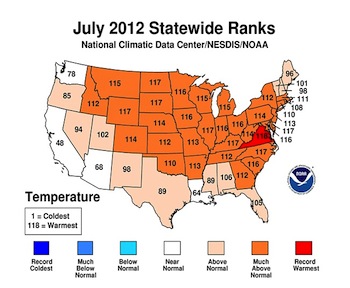How much longer can the US prioritize fuel over food?
As the country marks its hottest July ever (ever!) and the devastating drought gripping almost two-thirds of the country deepens, international pressure on the US to relax its ethanol quota is intensifying.
To meet the Renewable Fuels Standard, approximately 40% of the US corn crop is dedicated to producing biofuels. Even though some ethanol producers are reducing production voluntarily, US fuel companies are still required to use at least 9% ethanol in their supplies annually (about 12 billion gallons). As crop forecasts shrink, the chances for spiking food prices are increasing.
In an editorial in the Financial Times, United Nations director-general of Food and Agriculture, Jose Graziano da Silva, says relaxing the mandate could help avert a global food crisis.
"Much of the reduced crop will be claimed by biofuel production in line with US federal mandates, leaving even less food for food and feed markets," he writes. "An immediate temporary suspension of that mandate would give some respite to the market and allow more of the crop to be channeled toward food and feed uses."
The latest U.S. Drought Monitor, as of August 7, shows the percentage of corn and soybean crops in the two worst drought categories (D3 to D4, or extreme to exceptional drought) is still near 90% (slightly off a peak on July 24).
This situation has already caused a 6% increase in food prices, and the UN food agency is worried there could be a repeat of a 2008 food crisis. The UN is especially concerned about export bans and tariffs.
In its August crop report, the US Department of Agriculture says corn production for 2012/2013 is now forecast at 10.8 billion bushels – the lowest levels since 2006/2007 and off 13% from 2011.
The Ethanol Debate
The drought has prompted ethanol plants in Iowa and Nebraska to reduce production 20-30% to a two-year low, reports the Associated Press.
The industry believes cutting production further will have a minimal impact on food prices and will only end up making fuel significantly more expensive.
"The fact of the matter is this horrible drought has very painful supply and price implications for everybody," Monte Shaw, executive director of the Iowa Renewable Fuels Association, a trade group for the ethanol and biodiesel industries, told the AP. "Our role is to pull back first and the fastest. We’re already at a two-year low and where the economics take you is that the ethanol industry will bear the brunt of the rationing of available corn."
US ethanol plants are expected to produce 13.7 billion gallons this year, but that could slip to 12.5 billion gallons, according to industry forecasts. The US ethanol tax credit expired in early January 2012 after subsidizing the industry to the tune of $20 billion.
Biodiesel could pick up some of the ethanol slack, provided other crops like soybeans better than corn. Last year, 1.1 billion gallons of diesel fuel additive were produced.
"The watch word on biodiesel is so far, so good this year, but there certainly could be some challenges ahead," Shaw told the AP. "We’re still waiting to see what kind of soybean crop we’re going to have. Rain in the next few weeks will make or break the soybean crop."
US soybean production is forecast at 2.69 billion bushels, down 12% from last year.
When Will This End?
Unfortunately, relief from the parching weather isn’t anywhere in sight.
July was the hottest month ever for the US across the lower 48 states with an average temperature of 77.6 degrees Fahrenheit, beating the previous record set in July 1936.

The last 12 months was the warmest period ever recorded in the US, with about 63% of the country experiencing drought conditions.
Adding to the worries is news from Japan, where the official weather bureau has predicted that an El Nino phenomenon is emerging that could last until the winter. A prolonged El Nino in the region could cause widespread drought in Australia, parts of Africa, Southeast Asia and India.
One of the most troubling emerging patterns is the persistent nature of the heat, even at night, climatologist Jake Crouch told The New York Times.
"The hotter days increase the amount of moisture the lower atmosphere can hold, and this means it doesn’t cool off as much as night anymore," Crouch told The Times. "This clearly shows a longer-term warming trend in the US, not just one really hot month."
Climate Change Connections
Increasingly, respected scientists are pointing to this prolonged pattern of higher temperatures as a clear indication of planetary warming exacerbated by human-caused greenhouse gas emissions.
The latest argument is laid out in a newly published paper, "Perception of Climate Change," by James Hansen, the prominent NASA scientist.
In his introduction, Hansen points to unusually warm and cool seasons becoming more common in the past 30 years:
"An important change is the emergence of a category of summertime extremely hot outliers, more than three standard deviations warmer than the climatology of the 1951–1980 base period. This hot extreme, which covered much less than 1% of Earth’s surface during the base period, now typically covers about 10% of the land area. It follows that we can state, with a high degree of confidence, that extreme anomalies such as those in Texas and Oklahoma in 2011 and Moscow in 2010 were a consequence of global warming because their likelihood in the absence of global warming was exceedingly small. We discuss practical implications of this substantial, growing, climate change."
Hansen’s paper was actually submitted for peer review in late March, several months before we realized the extent of the current US drought.
A poll released in July shows that 70% of Americans believe climate change is real.
For Hansen’s climate change paper:

